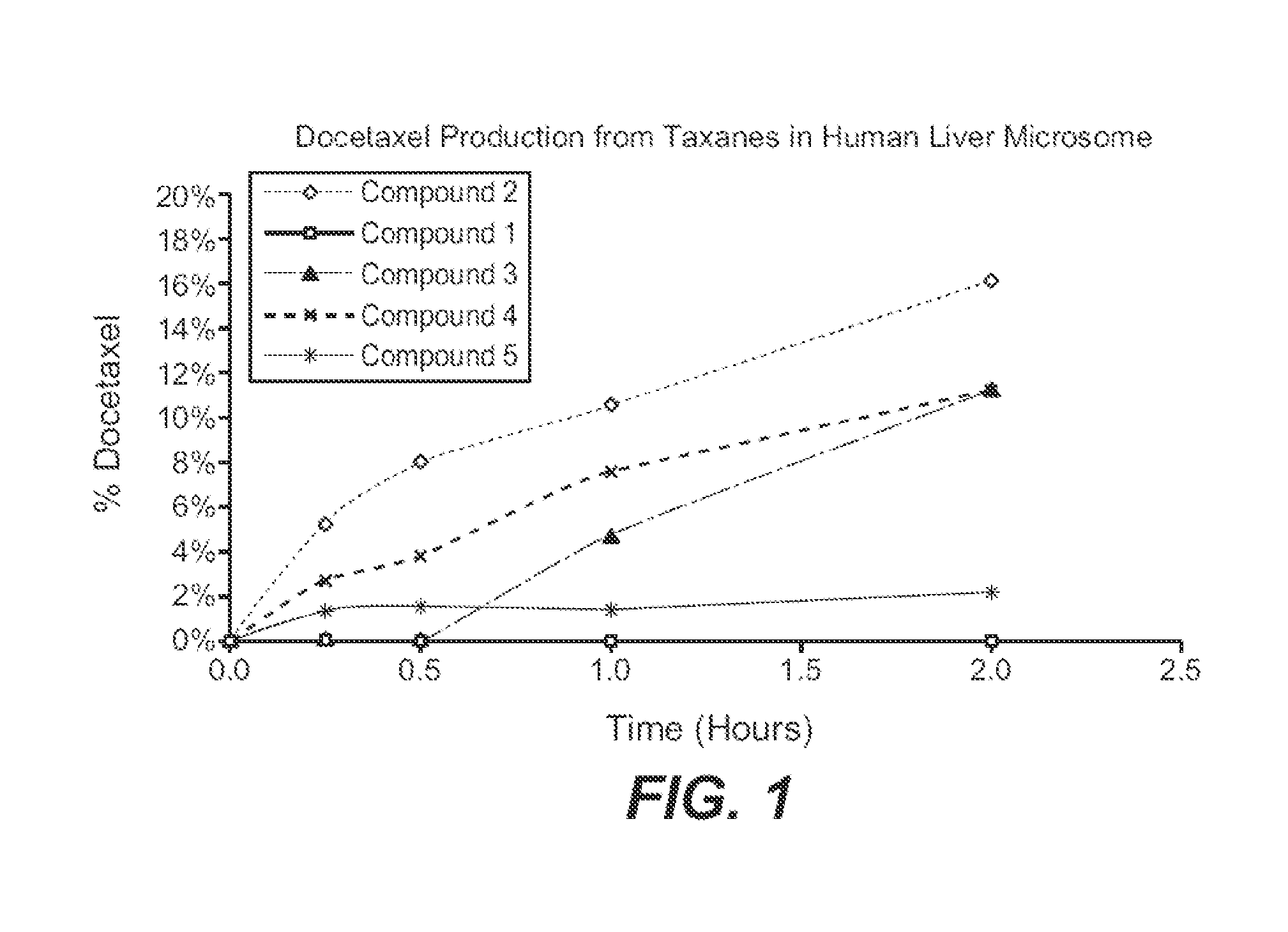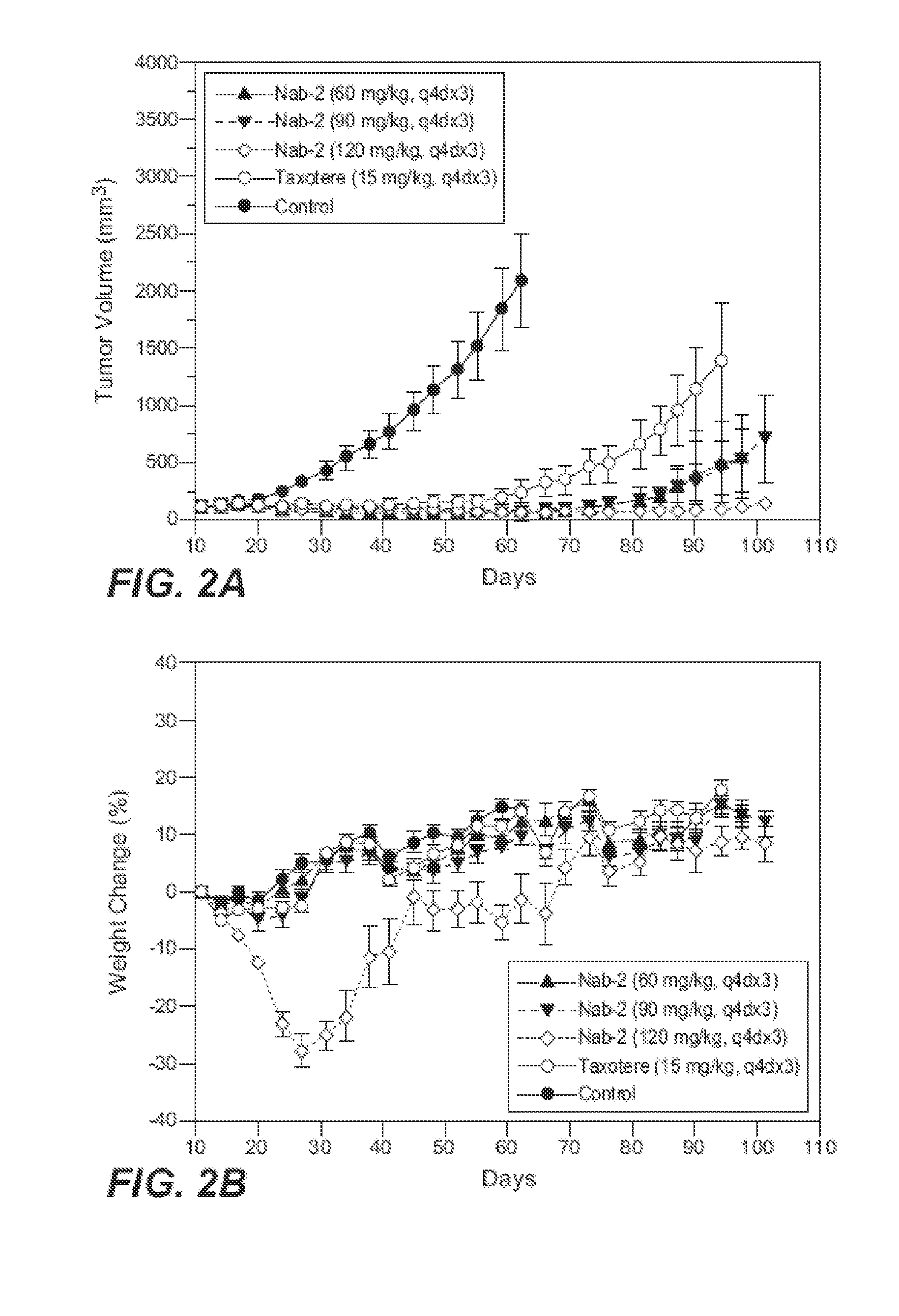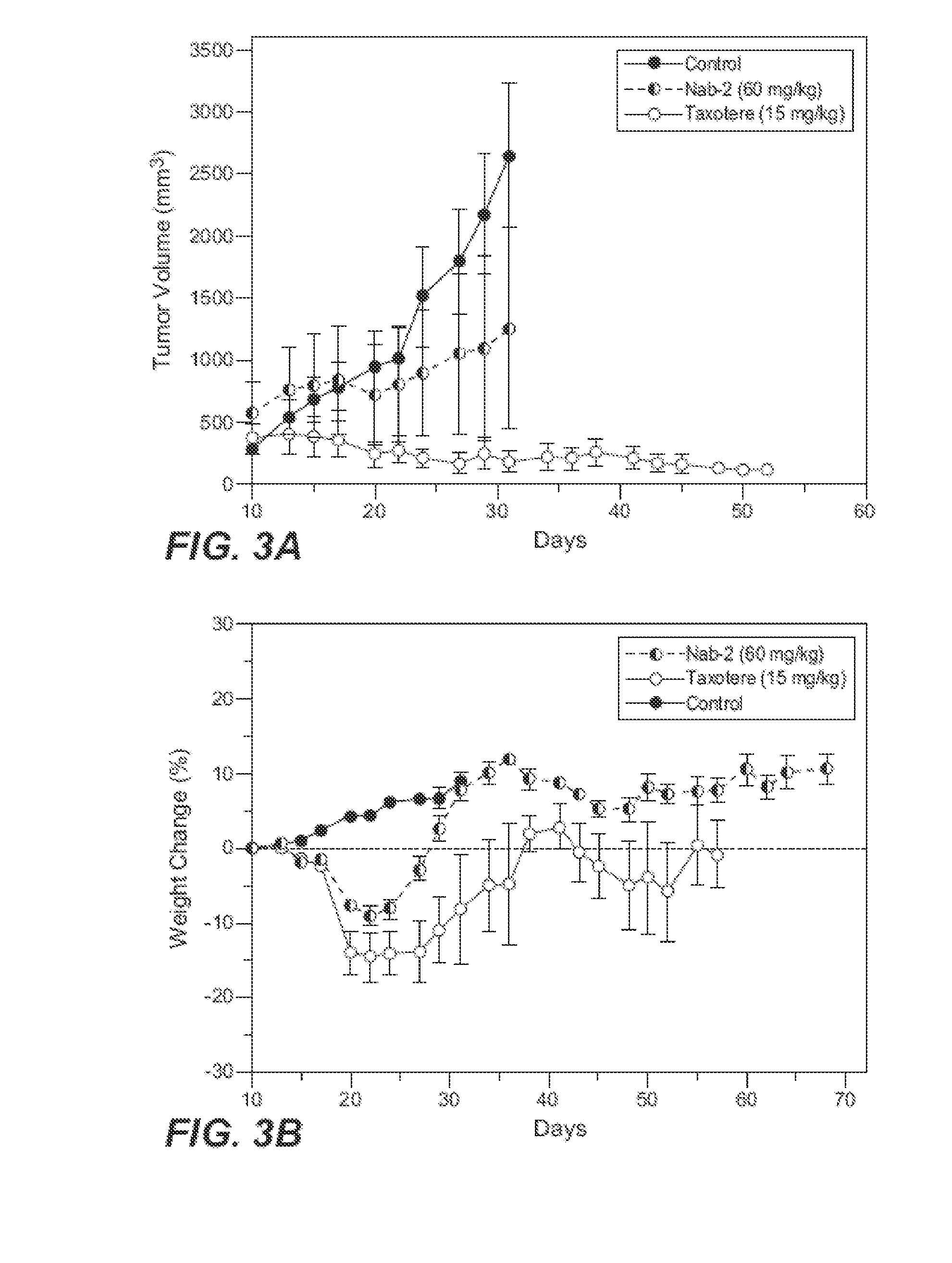Nanoparticle formulations and uses thereof
a technology of nanoparticles and formulations, applied in the field of nanoparticle formulations, can solve the problems of inability to practically formulate with an aqueous medium for iv administration, occurrence of hypersensitivity reactions, and poor water soluble paclitaxel, so as to improve the therapeutic effect, improve the binding to albumin, and improve the effect of paclitaxel and/or docetaxel
- Summary
- Abstract
- Description
- Claims
- Application Information
AI Technical Summary
Benefits of technology
Problems solved by technology
Method used
Image
Examples
example 1
Preparation of 2′-benzoyl-docetaxel (1)
[0275]
[0276]To a solution of docetaxel (201 mg, 0.25 mmol) in methylene chloride (6 mL) was added triethylamine (42 μL, 0.30 mmol), followed by benzoyl chloride (29 μL, 0.25 mmol) at 0° C. The mixture was stirred at room temperature for 2 h, upon which TLC indicated the disappearance of the starting material. After quenched with adding saturated sodium bicarbonate solution, the mixture was extracted by ethyl ether. The organic layers were washed by brine, dried over anhydrous magnesium sulfate, filtered, and concentrated in vacuo. The residue was purified by flash silica gel column chromatography (hexane: DCM, 1: 1) to afford the product as a white foam (181 mg, 80%). 1H NMR (CDCl3, 500 MHz): δ 8.10 (d, J=7.5 Hz, 2H), 7.98 (d, J=7.6 Hz, 2H), 7.61 (t, J=7.4 Hz, 1H), 7.50 (t, J=7.9 Hz, 2H), 7.45 (t, J=7.8 Hz, 2H), 7.41-7.36 (m, 4H), 7.29-7.26 (m, 1H), 6.25 (t, J=8.6 Hz, 1H), 5.67 (d, J=7.0 Hz, 1H), 5.58-5.45 (m, 3H), 5.22 (s, 1H), 4.94 (dd, J=9.6...
example 2
Preparation of 2′-hexanoyl docetaxel (2)
[0277]
[0278]To a solution of docetaxel (2.20 g, 2.72 mmol) in methylene chloride (220 mL) was added triethylamine (0.95 ml, 6.80 mmol), followed by hexanoyl chloride (0.38 mL, 2.72 mmol) at 0° C. The mixture was stirred at 0° C. for 1.5 h, upon which TLC indicated the disappearance of the starting material. After quenched with adding saturated sodium bicarbonate solution, the mixture was extracted by methylene chloride. The organic layers were washed by brine, dried over anhydrous sodium sulfate, filtered, and concentrated in vacuo. The residue was purified by flash silica gel column chromatography (10-50% ethyl acetate in hexanes) to afford the product as white solids (2.00 g, 81%). 1H NMR (CDCl3, 500 MHz): δ 8.10 (d, J=7.3 Hz, 2H), 7.61 (t, J=7.4 Hz, 1H), 7.50 (t, J=7.9 Hz, 2H), 7.38 (t, J=7.4 Hz, 2H), 7.30 (m, 3H), 6.25 (t, J=8.6 Hz, 1H), 5.69 (d, J=7.1 Hz, 1H), 5.46-5.37 (m, 3H), 5.21 (s, 1H), 4.96 (dd, J=7.7, 2.0 Hz, 1H), 4.32 (d, J=8.5 H...
example 3
Preparation of 2′-decanoyl-docetaxel (3)
[0279]
[0280]To a solution of docetaxel (144 mg, 0.18 mmol) in methylene chloride (10 mL) was added triethylamine (134 μL, 0.96 mmol), followed by decanoyl chloride (37 μL, 0.18 mmol) at 0° C. The mixture was stirred at 0° C. for 4.5 h, upon which TLC indicated the disappearance of the starting material. After quenched with adding saturated sodium bicarbonate solution, the mixture was extracted by methylene chloride. The organic layers were washed by brine, dried over anhydrous sodium sulfate, filtered, and concentrated in vacuo. The residue was purified by flash silica gel column chromatography (10-50% ethyl acetate in hexanes) to afford the product as white solids (112 mg, 65%). 1H NMR (CDCl3, 500 MHz): δ 8.10 (d, J=7.3 Hz, 2H), 7.61 (t, J=7.4 Hz, 1H), 7.50 (t, J=7.9 Hz, 2H), 7.38 (t, J=7.4 Hz, 2H), 7.30 (m, 3H), 6.25 (t, J=8.6 Hz, 1H), 5.69 (d, J=7.1 Hz, 1H), 5.46-5.37 (m, 3H), 5.21 (s, 1H), 4.96 (d, J=7.7 Hz, 1H), 4.32 (d, J=8.5 Hz, 1H), 4....
PUM
| Property | Measurement | Unit |
|---|---|---|
| Particle size | aaaaa | aaaaa |
| Temperature | aaaaa | aaaaa |
| Temperature | aaaaa | aaaaa |
Abstract
Description
Claims
Application Information
 Login to View More
Login to View More - R&D
- Intellectual Property
- Life Sciences
- Materials
- Tech Scout
- Unparalleled Data Quality
- Higher Quality Content
- 60% Fewer Hallucinations
Browse by: Latest US Patents, China's latest patents, Technical Efficacy Thesaurus, Application Domain, Technology Topic, Popular Technical Reports.
© 2025 PatSnap. All rights reserved.Legal|Privacy policy|Modern Slavery Act Transparency Statement|Sitemap|About US| Contact US: help@patsnap.com



